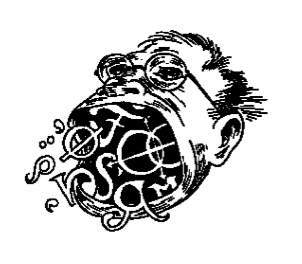“There is nothing like an arbitrary set of symbols to fix the operations of the mind.”
—Joanna Russ
John Cowan has written a 620-page grammar book for a language that does not exist. He is a master of Lojban, a perfectly logical language invented by a small group of people who want to remove all ambiguity from communication. Bob Griffin, a database designer who is fluent in Lojban, says, “This would be the ideal language for talking to non-terrestrials or non-mammalian life forms.”
Griffin and Cowan are not alone in their philological preoccupations. Stanford linguistics graduate student Doug Ball is the sole speaker and chronicler of Skerre, a language he invented at the age of thirteen. At UCLA, mathematics analyst James Carter has gained a tiny but enthusiastic following for creating Gua\spi, which he describes as “an artificial language suited to both humans and machines.” And every year at a celebration known as qep’a’, Klingon-speakers gather together with scions of the Klingon Language Institute to spend three days speaking nothing but the invented language of an imaginary species.
They call their passion conlang, short for “constructed language.” Some do it for political reasons, to bridge cultural barriers. Others are devoted to the aesthetics of an unsung medium.
Creating a new language requires a very specific form of consciousness. William Faulkner wrote compelling and gorgeous novels without knowing the first thing about the subjunctive mood, but comparable conlang geniuses cannot build a syntax without considering everything from verb positions to whether they will grant speakers access to a derogatory prefix. For this reason, conlangers tend to be people who are already immersed in specialized forms of symbolic communication. They are professional and amateur linguists, logicians, mathematicians, engineers, and software developers. They find elegance in a line of computer code; they feel the aesthetic power of calculus.
And they are all, in one way or another, idealists.
Whether a conlanger has contributed new idioms to Klingon in order to participate in a favorite science-fiction fantasy, or invented a tongue designed solely to reflect women’s consciousness, he or she is expressing an implicit wish to change the world with language. This urge was codified in what linguists call the Sapir-Whorf Hypothesis. Popularized in the mid-twentieth century, roughly the same time period when conlangers began forming their own communities and interest groups, this hypothesis holds that consciousness is structured by language. To change the way people think, all you have to do is change the language they use to do it.
Portrait of the Conlanger as a Young Artist
Most conlangers discover their predilections for language-building as postpubescents whose intellectual curiosity leads them into the obscure back alleys of...
You have reached your article limit
Sign up for a digital subscription and continue reading all new issues, plus our entire archives, for just $1.50/month.
Already a subscriber? Sign in





